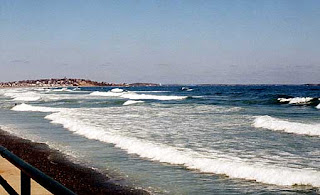Hello All, Below are the annotations of my student/sparring partner Billy Collins' amazing upset victories at the Bolyston Chess Club on June 12th. Sorry for the delay, as I was playing a few tournaments and of course, was busy playing Billy! After defeating an A player in round 1, Billy's next three opponents were all distinguished masters on average 300 points higher than he, and in one case, nearly 500. While Billy likes to remind opponents he is defeating in Harvard Square, "This is not tournament Daniel-Son, this is real!" (a reference to Karate Kid II), these tournament games were even more real, Billy!
-IM Marc Esserman1) Collins,Billy (2044) - Cherniack,Alex (2301) [C15](2)
[Marc Esserman]
1.e4 e6 2.d4 d5 3.Nc3 Bb4 4.Qg4!? 
A rare variation of the winawer, which first came into the limelight when Alekhine won quickly against Euwe in their 1935 World Championship match. White avoids the normal e5 c5 a3 Bxc3 bc3 c5 Winawer, and instead plans to wreck the black kingside immediately, but at the cost of a few queen moves. Never move your queen out early, they say!:)
4...Nf6 5.Qxg7 Rg8 6.Qh6 Rg6 7.Qe3 Diagram
Black has more development and white's queen is akwardly placed, but black's chief concern is that he cannot castle.
7...dxe4 [7...Nxe4 8.Bd3 With complications, as seen in Alekhine-Euwe.; 7...c5 perhaps the most logical continuation, in true French style.]
8.Nge2 b6 9.Bd2 Black's plan is too slow. White already threatens to win a pawn with Nxe4. Only a few moves ago it seemed that Billy was way behind in development, but after castles long--almost all of his pieces will be out.
9...Bxc3 Alex saves the e4 pawn for now, but at the price of giving up his Winawer bishop.
10.Nxc3 Bb7 11.0-0-0 Nbd7 [11...Nc6 Seeking more activity. After the text move black will have a hard time drumming up real counterplay.]
12.h3 [12.f3! exf3 13.gxf3 Qe7 14.Bd3 Is an alternative, with a clear advantage for white.]
12...Qe7 13.Rg1 0-0-0 14.g4 e5 15.Bg2 exd4 16.Qxd4 Nc5 17.Qe3
 Diagram Alex has done well to counter Billy's playable but slower plan of h3/rg1/g4/bg2 (which solved the problem of the g2 pawn, but at the cost of considerable time. The queen at e3 is still not ideally placed, but the e4 pawn is a prime target.
Diagram Alex has done well to counter Billy's playable but slower plan of h3/rg1/g4/bg2 (which solved the problem of the g2 pawn, but at the cost of considerable time. The queen at e3 is still not ideally placed, but the e4 pawn is a prime target.
17...Nd5 18.Nxd5 Bxd5 19.b3 Nd3+?! Diagram
 When quieter defense was necessary, Alex instead goes for the immediate knockout--a combination he surely envisioned before his 17th move. The problem is that a sacrifice is not really a sacrifice unless it must be accepted, and here taking the knight leads immediately to mate, whereas its decline leads black completely uncoordinated and on the full retreat.
When quieter defense was necessary, Alex instead goes for the immediate knockout--a combination he surely envisioned before his 17th move. The problem is that a sacrifice is not really a sacrifice unless it must be accepted, and here taking the knight leads immediately to mate, whereas its decline leads black completely uncoordinated and on the full retreat.
20.Kb1+/- [20.cxd3? Qa3+ 21.Kb1 Bxb3! 22.axb3 Qxb3+ 23.Ka1 Qa3+ 24.Kb1 Rd5! 25.Rc1 Rb5+ 26.Kc2 Qb3# ]
20...Nb4 21.Bxb4 Qxb4 22.Rd4 Qc5 23.Bxe4 Diagram
Billy's plan succeeds, the epawn finally goes.
23...Bxe4 24.Rxd8+ Kxd8 25.Qxe4 Qxf2 26.Rd1+ Rd6 27.Rxd6+ cxd6 28.Qa8+ Ke7 29.Qxa7+ Ke6 Diagram Black must now struggle for a draw a pawn down in a difficult queen ending. An active king, normally a good thing in the endgame, is here a target to multiple checks by the white queen. White's fast b and a pawn's will be very difficult to stop.
Black must now struggle for a draw a pawn down in a difficult queen ending. An active king, normally a good thing in the endgame, is here a target to multiple checks by the white queen. White's fast b and a pawn's will be very difficult to stop.
30.Qc7 Qf1+ 31.Kb2 Qxh3 32.a4 Qxg4?? Diagram
A blunder stemming from an attempt to restore the material balance. A hard defense was ahead nonetheless.
33.Qc8+ 1-0
...............................
(2) vigorito (2532) - collins (2044) [A40][Marc Esserman]
Billy had ascended one cliff, but the mountain kept getting higher, this time in the form of IM +2500 David Vigorito, and with the black pieces to boot. So many times when a player achieves a great upset in sports, he has no energy left for the next, often higher obstacle in his path. Billy would try to avoid this pitfall. 1.d4 Nf6 2.c4 e6 3.Nc3 c5 4. d5 exd5 5. cxd5 d6 Diagram

The famous Benoni, whose Hebrew translation literally means, "Son of sorrow." However, it is the favorite son of many Bolyston Chess Club experts and masters, despite Kasparov's warning that it has been refuted. Unlike the more stable Queen's Gambit declined, it is a declaration of all-out war.
6.Nf3 g6 7.Nd2 Diagram

When Nimzovitch first invented this "undeveloping" move, many were puzzled. Now the commonplace maneuver is known to all masters--the knight journeys to c4, hoping to bring the d6 pawn to tears.
7...Bg7 8.e4 0-0 9.Be2 a6 10.a4 Securing the beast's formidable outpost. 10...b6?! Diagram
too slow for a benoni---Nbd7 and Re8 is preferred, if Nc4 then perhaps Nb6
11.0-0 Nbd7 12.Nc4 Ne8 The d6 pawn begins to shed a tear.
13.f4 Diagram 
White's position grows overwhelming. Billy senses this danger and felt the need to mix it up with his far more experienced and solid opponent. In the post game, Billy claimed with fervor: "The Benoni, these are my kind of positions!" As you will see, while white has the edge, he will be posed plenty of problems on the road to realizing his advantage.
13...f5 14.exf5 gxf5 15.Bd3 Rb8 16.Qc2 Bd4+ 17.Kh1 Qf6! Diagram

Connecting logically to Bd4+, which at first seemed like a stray move. The queen serves many purposes here, working on the long diagonal, ready to attack the kingside, and of course, wiping up the tears of the d6 pawn.
18.Ne3 Ng7 Billy's eccentric scheme of development is beginning to take shape--the weaknesses at f5 and d6 are in good hands.
19.Ne2 Diagram 
19...Bxe3?! [19...b5! 20.axb5 axb5 Is far stronger, as if 21.Nxd4 cxd4 22.Nd1 Qf7 Black will win the key d5 pawn--although the outcome is still in doubt.]
20.Bxe3 b5 21.axb5 axb5 22.Nc3 c4 23.Be2 Re8 24.Bf2 Qg6 25.Ra5 Diagram

Billy's posit ion has far too many defects now and at this point Vigorito is winning.
25...b4 26.Nb5 Re4 27.Bxc4 Rxf4 Diagram

28.Bg3 [28.Ba7! And Billy would have to resign, as both rooks are hanging and 28...Rxf1+ 29.Bxf1 Ra8 or 30.Qc6! (30.Nc7 wins the lonesome rook.) ]
28...Rg4 29.Bxd6 the d6 pawn has shed its last tear. White is still winning.
29...Nb6 30.Bb3 Rb7 31.Bc7 Bd7 Diagram

Here white can win beautifully with 32.d6+
[32.Qc6! Bxc6 33.dxc6+ Kh8 34.cxb7 and the queen reappears!]
32...Ne6 33.Qf2? Diagram
[33.Re1+-]
33...Nc4! Billy is back on the path, as white's pieces have become loose and misplaced.
34.Ra8+ Kg7 35.Na7 Nxc7 36.dxc7 Rxc7 37.h3 Re4 38.Bc2 Ne3? Diagram
[38...Re5 would be calmer, as white has few threats with his two pieces on a7 and a8 missing in action.]
39.Bxe4 Nxf1 40.Qxf1 Diagram

[40.Bd5! with the threat of rg8 would leave white back on top. 40...Ng3+ 41.Kh2 Nf1+ 42.Kg1] 40...Qg5 White is a piece up, but the rook and knight are tied to each other, the bishop may hang in the near future, and most importantly, rc1 threatens to win the queen! [Billy avoids falling off the cliff with 40...fxe4 41.Qf8#]
41.Qf3 Rc1+ 42.Kh2 fxe4 Diagram

43.Qxe4 [43.Qf8+ Would have secured the draw, but white was still playing to win. 43...Kg6 44.Qg8+ Kh6 45.Qf8+ Kg6 (45...Qg7 46.Qd6+; 45...Kh5 46.Qf7+ Kh6=) 46.Qg8+=]
43...Qf6 44.Qe3 Qd6+ 45.Qg3+ Qxg3+ 46.Kxg3 Diagram

Again, white is a pawn up, but he must be worse, as he is virtually a piece down.
46...Rc2 47.Rd8 Rc7 48.Ra8 b3 49.Kf4 Diagram

Rc2 [49...Kf6 is best, keeping the king at bay.]
50. Rd8
[50. Rb8! with the idea of Rb7, would have amazingly freed the white pieces and simultaneously frozen black's! A mirror image! ... Rxb2 51. Rb7 Diagram  ]
]
50...Ba4! 51. Rd4 Be8! Diagram

White is now in serious trouble, but a final blunder in time pressure ends the battle.
52.Nc8?? Rxc8 53.Rb4 Bf7 54.g4 Rc2 55.Kg5 h6+ 56.Kh4 Rxb2 57.Kg3 Rc2 58.Kf3 b2 0-1
................................
(3) collins (2044) - chase (2378)
[Marc Esserman]
With the valley in sight, there was one only one more cliff to scale, current Bolyston Champion Chris Chase.
1.e4 g6 2.d4 Bg7 3.Nf3 d6 4.h3 Diagram

Chase is an expert in these theoriless, amorphous, "modern defense" positions. The goal is to simply outplay the opponent from a slightly worse start.
4...a6 5.c4 e5?! 6.dxe5 dxe5 7.Qxd8+ Kxd8 Diagram

Sometimes these queenless middlegames are acceptable for black, sometimes they are not. Here white has a clear advantage. When I saw this position I felt confident that Billy would complete the miraculous 4-0 feat.
8.Nc3 Nc6 9.Be3 h6 10.0-0-0+ Bd7 11.c5 Kc8 12.Bc4 f5 13.Kb1 Nf6 14.Nh4 f4 15.Bc1 g5 16.Nf5 Bf8 Diagram 
But how quickly things can change--Chase is now clearly in command. The c5 pawn is lost. White's only trump is the awkward position of the black king.
17.h4 I would have preferred 17...g4 [17...Nxe4! 18.Nxe4 Bxf5 When it becomes clear that white needs to save himself.
19.Bd3! gxh4 20.Nd6+ cxd6 21.Bxf5+ Kc7 22.cxd6+ Bxd6 23.Rxh4 And white is fighting for a draw.] 18.f3 Bxc5 19.Nd5 Nxd5 20.Rxd5 Bf8 Diagram

[20...gxf3! presents another obstacle, as Rxc5? 21.Rxc5? leaves white's chances in doubt after 21...fxg2 22.Rg1 f3 23.Be3 b6 24.Rd5 Be6!] 21.Rdd1?! [21.fxg4!+/- Both players thought this move was impossible due to the impending be6, 21...Be6 but 22.Rxe5! Bxc4 (22...Nxe5 23.Bxe6+ Kb8 24.Bxf4 Diagram

And white is dominating the board with a pawn for the exchange plus considerable activity.) 23.Re8+ Nd8 24.Rd1+- With catastrophic material loss] 21...g3 22.h5 Diagram

the start of an amazing final coup--the h1 rook will travel first to h4--then to g4--and then.... 22...b5 23.Bf7 black's king is still chained to the bishop 23...Nd8 24.Bb3 c6 25.Rh4 Kc7 26.Rg4 Ne6 27.Bd2 a5 28.Bc3 Diagram

[28.Bxe6!+- even more effective, preventing the defensive in the game.] 28...Nd4 29.Bxd4 exd4 30.Rxd4 a4 31.Bf7 Diagram

31...Bc5?! [31...Rd8! After some nervous play the advantage slips back to black--but why?
32.Rxf4 Bc5! 33.Rd1 Bxf5 34.Rxd8 Rxd8 35.Rxf5 Be3! Diagram
and amazingly the g pawn cannot be stopped--a very difficult idea to find under pressure.] 32.Rd1 a3 33.b3?! [33.Rg7! The rook has been screaming to go to g7 ever since h4-h5!] 33...Raf8? [33...Bxf5! black's last chance to free himself, a chance that if taken that would have won! 34.exf5 Rad8 35.Rxd8 (35.Rc1 Be3 36.Rc2 Rd1+) 35...Rxd8 36.Kc2 Be3 and the gpawn again runs to the goal line.] 34.Rg7! Diagram

Finally the rook realizes its full potential! 34...Kc8 35.Bg6 Rd8 36.Nd6+
And black's flag fell in a lost position. 36...Bxd6 37.Rxd6 Rhg8 38.Rgxd7 Rxd7 39.Bf5 Rgd8 40.Rxh6 Diagram 
would win in a rook ending. The end of an amazing journey for USCF expert, and I predict soon to be master, Billy Collins. His performance rating during the tournament of 2932 is fitting for a hero. 1-0
 Laurence Maroney had a captive audience earlier today, as he explained how he’s using the game of chess to help make him a better football player.
Laurence Maroney had a captive audience earlier today, as he explained how he’s using the game of chess to help make him a better football player.













































